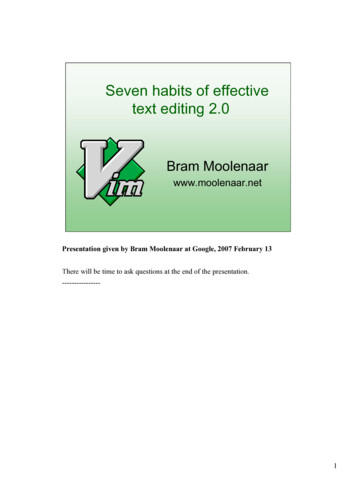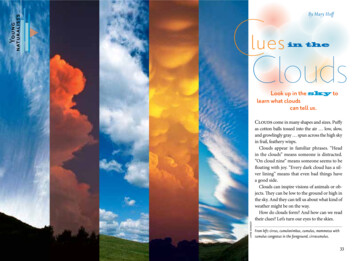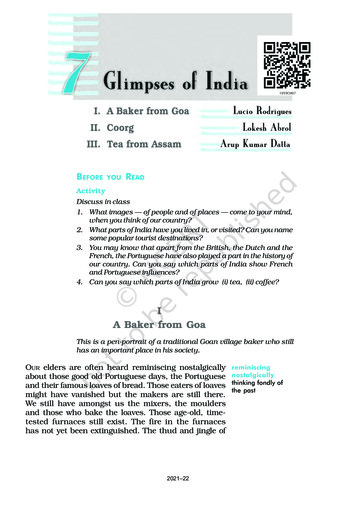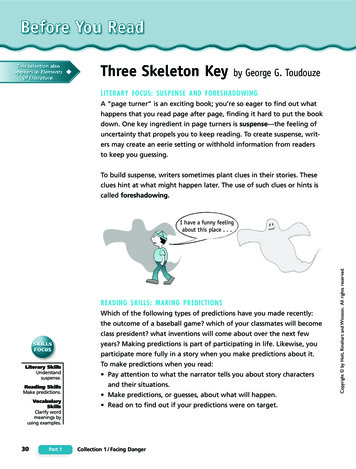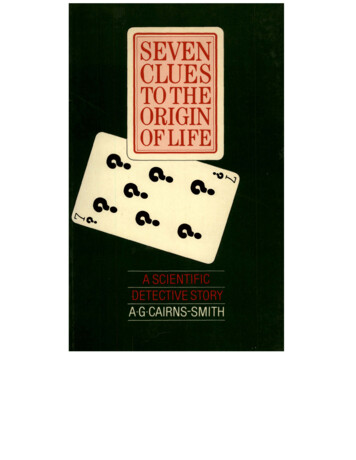
Transcription
SEVENCLUESTO THEORIGINOF LIFEo.---."· "-"·O."··o "·"·
Seven clues to the origin of lifeascientific detective storyA. G. CAIRNS-SMITHg.n " oi ""u,.,,.,.,,,o/C Pfflwotir "'Iff"""*'''//al/ .,,.fH I:r,,,.,.,,.JbyHt"'Y lllll lf!JJ4TlrtrU"''"''"'YJwlli"'"'""Gftdpwb/lJ-dC Ptl lfWMJI,/IMtHI#CAMBRIDGE UNIVERSITY PRESSCambridgeNew York New RochelleMelbourne Sydney
Published by the Press Syndicate of the University of CambridgeThe Pitt Building, Trumpington Street. Cambridge CB2 1 RP32 East 57th Street. New York. NY 10022, USA1 0 Stamford Road. Oakleigh, Melbourne 3166. Australia Cambridge University Press 1985First published 1985First paperback edition 1986Reprinted 1987 1988 (twice)Printed in Great Britain by the University Press. CambridgeLibrary of Congress catalogue card number: 84-2 3044British Library Cataloguing in Publication DataCairns-Smith. A. G.Seven clues to the origin of life: a scientific detective story.1. Life - OriginI. Title577QH325ISBN 0 521 27522 9 hard coversISBN 0 521 33793 3 paperbackUP
To Sarah, Adam and Emma
CONTENTSPreface ixSources of quotations xi1Inquest12 essages, nnessages93Build your own E. coli164The inner nnachinery225A garden path?316Look nnore closely at the signposts387A clue in a Chinese box508 issing pieces589The trouble with nnolecules6510Crystals7411The clay-nnaking nnachine8012Gene-18713Evolving by direct action9814Takeover10715Sunnnning-up: The seven clues114Appendix 1117Appendix 2120Glossary125Index128
PREFACE·Odd. Watson- very odd!·Faced with a really difficult-looking problem should one follow theadvice of Descartes or of Holmes? Should one proceed step by stepfrom what is easily understood, as Descartes advised, 'starting withwhat was simplest and easiest to know, and rising little by little to theknowledge of the most complex' ? It sounds like good advice and onthe whole modern science takes it. But the methodical step-by-stepstrategy does not always work. First steps can be particularly trickyand you have to know in which direction to go. There are times whenyou need the advice not of Descartes, but of Sherlock Holmes.You see Holmes, far from going for the easy bits first, wouldpositively seek out those features in a case that were seeminglyincomprehensible - 'singular' features he would call them. They canpoint the way. They can tell you what sort of a problem it is thatyou are dealing with. If you can see how the murder could have beendone at all with the door and windows securely fastened ., or if youcan understand why on earth the thief should have rung the bell thatgave away his presence in the room ., why then, you may even havecracked the whole thing.I think that the origin of life is a Holmesian problem - that if wecan understand how life could have started at all, then we should beable to work out, roughly at least, how it did start.Much of this book is devoted to seeking out, and making as starkas possible, the difficulties in the case of the origin of life on the Earth.Not so that we can throw up our hands and say 'Look how impossibleit all is!' Not at all. Rightly or wrongly we will be assuming that lifereally did arise on this Earth 'from natural causes'. We look fordifficulties to see as clearly as possible what the real problem is, andto fashion a key to unlock it.Seven Clues . started from an idea to write a layman's version ofmy book Genetic Takeover- something much shorter, with only a fewix
PrefaceXtechnical terms and diagrams, and no references. Since in any casethe problem of the origin of life is one that calls for detective work.I thought it would be amusing to write the new book somewhat inthe style of a detective story. You can read it like this if you wantto, trying to foresee the curious conclusion that will start to emergearound chapter 10.There will be plenty of other implicit questions for you to thinkabout: What are the real difficulties? Which are the main suspects?Where are the red herrings? What are the best clues? (Or anywaywhat does the author think they are?) My choice of the seven bestclues, dropped at various stages in the book, will be listed and locatedexplicitly in the final chapter.I decided to have no references because (i) laymen are notparticularly interested in who did what when, (ii) the cognoscentiknow pretty well anyway, and then (iii) because I had already writtena book that was full of references. So you will find no more than alittle light name-dropping here and there. For laymen I need onlystress that not all the ideas are original by any means: even thosethat have some originality are derived from earlier ideas, and in anycase the whole background of knowledge that allows one even to startspeculating about our origins depends on innumerable experimentsand observations by others. Then again ideas have been formed,sharpened - or thrown out - as a result of very many discussionswith friends and colleagues over many years.I would like to thank in particular those who actively helped inthe preparation of this book, by reading the manuscript and discussingit with me: Paul Braterman, Colin Brown, Roger Buick, Jack Cohen,John Freer, Sally Gibson, Hyman Hartman and Kelvin Tyler, as wellas my wife Dorothy Anne and my son Adam. I am grateful also toJanet Mcintyre and to my daughter Sarah who got the wordssmoothly onto the typescript by various electronic means.Glasgow, Spring 1984Graham Cairns-Smith
SOURCES OF QUOTATIONSQuotations at the start and finish of each chapter are from theSherlock Holmes stories of Sir Arthur Conan Doyle.(A, Adventures; C, The Case Book;L, His Last Bow; M, Memoirs; R, TheReturn.)Onpage:From:1The Naval Treaty (M)8The Hound of the Baskervilles (Ch. 3)915The Musgrave Ritual (M)A Study in Scarlet (Ch. 4)16The Disappearance of LadyFrances Carfax (L)21The Adventure of the Bruce-Partington Plans (L)22The Adventure of the Second Stain (R)30The Sign ofFour (Ch. 6)31The Bascombe Valley Mystery (A)37The Valley ofF ear (Part 1, Ch. 6)38The Adventure of the Priory School (R)49The Adventure of the Second Stain (R)50The Adventure of the Shoscome Old Place (C)57The Disappearance of LadyFrances Carfax58The Valley ofFear (Part 1, Ch. 6)64The Adventure of the Priory School (R)65The Reigate Puzzle (M)73The Naval Treaty (M)74The Adventure of the Beryl Coronet (A)79The Adventure of Black Peter (R)80The Disappearance of Lady Frances Carfax86The Adventure of the Creeping Man (C)xi(L)(L)
xii87Sources of quotationsA Study in Scarlet (Ch. 3)97The Hound of the Baskervilles (Ch. 15)98Silver Blaze106(M)The Adventure of the Empty House (R)107The Valley of Fear113The Adventure of the Beryl Coronet (A)114Silver Blaze116The Valley of Fear(Part 1, Ch. 6)(M)(Part 1, Ch. 7)Preface The Adventure of the Solitary Cyclist (R)
1Inquest'Do you see any prospect of solving this mystery. Mr. Holmes?' she askedwith a touch of asperity in her voice.'Oh. the mystery! ' he answered, coming back with a start to the realitiesof life. 'Well, it would be absurd to deny that the case is a very abstruseand complicated one, but I can promise you that I will look into thematter and let you know any points which may strike me.''Do you see any clue I ''You have furnished me with seven, but of course I must test thembefore I can pronounce upon their value.''You suspect someone? ''I suspect myself.''What!''Of coming to conclusions too rapidly.'Whatever one might read in the newspapers there is not much realdistress among biologists about the fundamental idea of biology which is evolution. There may be arguments still about how, and howfast, evolutionary changes took place. But that evolution did takeplace is hardly an issue any more. The idea that the multitudinousforms of life on the Earth have evolved from common ancestors owesits security not to some single demonstration but to a more day-to-dayexperience of biologists- that this idea fits with innumerable detailedand general observations. In providing a global view of the relatednessof life it is an idea that makes biology into a coherent subject. Biologyhas become, quite simply, the study of the causes and effects ofevolution, and the question of the origin of life is, first, the questionof the origin of evolution.But to frame the matter in this rather stolid way is not to deny thatthe case of the origin of life on the Earth is an abstruse andcomplicated one. There are clues certainly, many more than Holmes'seven, but their significance is indirect and the most obvious are notalways the most important. We will be thought-testing many of theseclues, detecting a number of red herrings, and avoiding coming toconclusions too rapidly. What will emerge will be seven clues thatseem to be of particular use, and an overall view of the origin of lifethat these clues suggest.Before we can really get started there are some words to disentangle.First, there is the word life.1
Seven clues to the origin of life2My dictionary tells me that life is the period between birth anddeath - but that is not what I want to talk about. This book is aboutlife as a phenomenon - as in 'life on the Earth'. Life is a propertythat is shared by man, moulds and marigolds. It is a rather fuzzyproperty, unfortunately, notoriously difficult to pin down, even ifobvious enough in most cases.I prefer uses of the word 'life' that admit the fuzziness, that do notpin down but somehow encompass the general idea. Coleridge'sdefinition is like this: 'I define life as . a whole that is pre-supposedby all its parts'. After all what impresses us about a living thing isits in-built ingenuity, its appearance of having been designed,thought out - of having been put together with a purpose. Life canbe thought of as a kind of naturally occurring machinery. We cansee what the purpose of a living thing is: itis to survive, to compete,to reproduce its kind against the odds.Coleridge, it must be admitted, was looking for something morepoetic than machinery - for some deeply mysterious unifying power.a principle of life, an essential magic about living things that dividesthem from everything else. That is what we call vitalism. It isofficially outmoded; but there are still resp cted scientists, physicistsmainly, who seem to want of 'life' more than machinery: who wouldseek some profound division. There is a temptation, in any case, tosuppose that if the origin of life was not actually supernatural it wasat least some very extraordinary event, an event of low probability,a statistical leap across a great divide. That way a trace of magic canbe held on to.I am much more inclined to an opposite prejudice - a majorityprejudice now. This is to suppose that the exorcism that Darwininitiated will continue right back to the origin of life.Darwin persuades us that the seemingly purposeful constructionof living things can very often, and perhaps always, be attributed tothe operation of natural selection. If you have things that arereproducing their kind; if there are sometimes random variations,nevertheless, in the offspring; if such variations can be inherited: ifsome such variations can sometimes confer an advantage on theirowners: if there is competition between the reproducing entities - ifthere is an overproduction so that not all will be able to survive toproduce offspring themselves - then these entities will get better atreproducing their kind. Nature acts as a selective breeder in thesecircumstances: the stock cannot help but improve.You can see that natural selection is a good bit more than just
IInquest3'survival of the the fittest' : there are all those ' ifs '. And naturalselection is only one component of the mechanism of evolution. Anytheory that is to explain the variety and complexity of living thingsmust also take into account the varied and varying challenges set upby a varied and varying environment. Nature, as breeder and showjudge, is continually changing her mind about which types shouldbe awarded first prize: changing selection pressures have been a keypart of her inventiveness.But nevertheless natural selection has been the key component. thesine qua non. Without it, living things could not even stay adaptedto a given set of circumstances, never mind become adapted to newones. Without natural selection the whole adventure would neverhave got off the ground. That kind of in-built ingenuity that we call'life' is easily placed in the context of evolution: life is a product ofevolution.Life, then, is not some absolute quality that would have suddenlyappeared, it would have emerged gradually during early evolution.Between the first evolving entities, that first conformed to those 'ifs',and later forms that did so more cleverly, there would have been nohard line. But who cares? When you can see what is going on in sucha progression you lose interest in erecting picket fences. As I said,'life' is a fuzzy idea- and it is best left like that.But wait a minute, you may say, do you not need living things togenerate 'life' in this way?No. What is needed for evolution is natural selection, and whatis needed for natural selection are things that conform to those 'ifs '.There is nothing in the rules to say that such things had to be 'living'.We have an odd view now because all of those things that we areaware of that can evolve have evolved.So the start of our problem seems clear enough: if we are to cometo understand the origin of life - which would have been a gradualemergence- we must first understand the origin of evolution. Wemust first find things that can evolve but have not yet done so. Ifindeed there were such things that were in at the start of evolutionthere should still be things like them to be found or made.Organism is another word that can be placed in the context ofevolution: organisms are participants in evolution. More specifically,for our purposes, organisms are prerequisites for evolution. Those firstevolvable things that we have just been talking about would not yethave been 'living' - but they would still have been organisms.It might seem that by far the most difficult parts of the problem
Seven clues to the origin of life4of the origin of life had already been solved in principle once therewas a general understanding of the way evolution works and of theway in which organisms reproduce and pass on characteristics tooffspring. Already towards the middle of this century there werebiochemists and others who felt that there might be only a little gapbetween some bacterium of the kind that could be seen as asomewhat unstructured blob under a microscope, and some stillsmaller congregation of molecules that might have been a starterorganism for evolution.The early fifties were a high point of optimism. The molecular basisof heredity had suddenly been uncovered, and prevailing ideas aboutconditions on the primitive Earth suggested that the component partsfor such molecular machinery would have been just lying about. Itwas thought that the atmosphere on the early Earth would have beenlike Jupiter's atmosphere now; that it would have been dominatedby gases such as hydrogen, methane and ammonia. It had beenshown that with such gases some of those amino acids that are nowfound in all organisms can be made fairly easily. Given such piecesthere was always chance to do the rest, and who knows, there mightbe special effects to be discovered that would reduce the amount ofluck that would be needed.The optimism persists in many elementary textbooks. There is even,sometimes, a certain boredom with the question; as if it was nowmerely difficult because of an obscurity of view, a difficulty ofknowing now the details of distant historical events.What a pity if the problem had really become like that! Fortunatelyit hasn't. It remains a singular case (Sherlock Holmes' favourite kind):far from there being a million ways in detail in which evolution couldhave got under way, there seems now to have been no obvious wayat all. The singular feature is in the gap between the simplestconceivable version of organisms as we know them, and componentsthat the Earth might reasonably have been able to generate. This gapcan be seen more clearly now. It is enormous.Three prime factsBy far the most remarkable fact of this case is already known toreaders:Fact one:There is life on the EarthThat there is a profusion of forms of life will not have goneunnoticed either; but it is much less apparent that this profusion is,
1Inquest5biochemically, somewhat superficial. If you could use a big enoughmagnifying glass you would find that there is really only one kindof life on the Earth: the most central machinery in all organisms isbuilt out of the same set of micro-components, the same set of smallmolecules. We have then:Fact two: All known living things are at root the sameBut the fact that causes all the trouble is this one:Fact three: All known living things are very complicatedWhile it may be so that several of the common micro-componentsare fairly simple molecules in themselves, they collaborate in a waythat is both highly organised and complex. This in itself might bedismissed with a waving hand as a product of evolution (' - of coursethings would have been much simpler to start with-'). But the realtrouble arises because too much of the complexity seems to benecessary to the whole way in which organisms work. Our kind oflife is 'high-tech'. Even some of those essential micro-components arenot at all easily made. We will be returning to the perplexities of factthree.Questions of time and circumstanceThe Earth is 4.5 billion (thousand million) years old. This is quite areliable figure. The ages of many ancient rocks are reliable too, andthey go back a long way: there are rocks in Greenland that are 3.8billion years old. The first signs of life in ancient rocks are not so easilydated (or identified), but there is good evidence now for microbes ofsome sort having been on the Earth at least by 2.8 billion years ago.This is a cautious estimate; most experts would say that there is nowpretty good evidence for life on the Earth 3.5 billion years ago. A fewwould put the date as far back as 3.8.The most direct evidence is twofold. First there are rather curiouslarge-scale structures in many ancient rocks, including 3.5-billion year-old Australian rocks, that resemble structures (stromatolites)that today are produced by large colonies of microbes. And thensecond, there are objects found in ancient rocks that appear to befossils of microbes themselves.Moving to the other end of the time range for the origin of life onthe Earth, the earliest possible date is fixed by the age of the Earthitself, but there is evidence from the Moon and other planets that theEarth was being bombarded by very large meteorites up to about 4.0billion years ago. So the long-stop is perhaps nearer 4.0 than 4. 5
Seven clues to the origin of life6billion years ago. On the other hand the (cautious) 2.8 date for thenear end of the range is likely to move further away with newevidence. So, probably, the gap will narrow. But in the meantime wecan be content with a time range of 4.5 (or less) to 2.8 (or more)billion years ago for the origin of life on the Earth.As for the conditions on the Earth when life originated, the bestevidence that we have is from those Greenland rocks, 3.8 billion yearsold. That date is well within our range for the origin of life. The rocksthemselves speak of an Earth that was not so vastly different fromtoday. These rocks used to be sediments: they were laid down underlarge bodies of water. And there was presumably land too, to providethe materials to be sedimented. The Greenland rocks containcarbonates - sotherewaspresumablycarbondioxideintheatmosphere - and also iron-containing sediments of a kind that, mostprobably, could only have been formed if there had been little or nofree oxygen in the atmosphere. And it is generally supposed that therewas also nitrogen in the early atmosphere to provide the mainconstituent, as now.Of that early, heavy, Jupiter-like atmosphere, full of methane,ammonia and such things, there is no evidence from ancient rocks;and there is little enthusiasm for the idea now, either amonggeologists, geochemists or planetary astronomers.Finally, let us look briefly at four extreme attitudes of the sort thattend to obliterate further enquiry.Was the law broken?It is a sterile stratagem to insert miracles to bridge the unknown.Soluble problems often seem to be baffling to begin with. Who wouldhave thought a thousand years ago that the size of an atom or theage of the Earth would ever be discovered? Poor Dr. Watson wasalways being baffled by Sherlock Holmes' cases - as we all are by agood conjuring show. It is silly to say that because we cannot see anatural explanation for a phenomenon then we must look for asupernatural explanation. (It is usually silly anyway.) With so manypast scientific puzzles now cleared up there have to be very clearreasons not to presume natural causes. Let us not say that the lawwas broken.Was there a freak event?We touched on this already. The argum nt goes along these lines.If the Universe is infinite in time or space then any circumstance witha finite probability will happen (an infinite number of times to boot).
1Inquest7Hence the first organism could have appeared on the Earth by chance.That no life has been found elsewhere in the Universe can be takenas evidence in support of this contention. This is the scientificallyrespectable version of the special miracle. It is just as sterile. If lifecould have started without a freak event then that is the way thatit would have started.Was there a frame-up?Then there is an idea, developed particularly by Brandon Carter,called 'the anthropic principle'. We must be in a Universe that madeour existence possible, so the Universe that we are in may very wellbe a freak Universe self-selected from myriads of others - or somemight say specially contrived by God. According to this idea the lawsand constants of Nature, and/or the initial conditions for theUniverse, were in effect tuned to allow the production of consciousbeings. Maybe so. But as with the freak event idea, there is no reallet-out. However contrived our Universe may be we should be lookingfor the least improbable way in which life could have started withinthat Universe.Was it an outside job?Perhaps life did not start on the Earth. but seeds of some sortarrived from elsewhere.In the early part of this century the Swedish chemist SvanteArrhenius speculated that the pressure of light waves could havepushed spores from one planetary system to another. Alternativelymeteorites have sometimes been suggested as carriers, buried sporesbeing thus protected, on their journeys, from destructive radiation.There are practical questions of whether in fact spores wouldsurvive such journeys or be likely to find another locale suited tothem. The idea suffers too from the objection that the problem issimply being displaced. At least we know that life can thrive on theEarth - on the face of it the Earth then seems as good a place as anyto try to imagine the origin of life.More recently Fred Hoyle and Chandra Wickramasinghe havespeculated that in the vast reaches of interstellar space conditionsmay be particularly suited to the origin of life. Space then might befull of spores that had never been on a planet. Perhaps, though, suchspace-borne organisms could nevertheless infect a planet such as theEarth. This time the problem is being displaced more radically, byintroducing the idea that perhaps space would be a better place forthe critical initial phases of an evolutionary process. But that point
Seven clues to the origin of life8is not at all clear; and it is not clear either that organisms that hadevolved in space would survive under the very different conditionsof a planetary surface. There are similar attractions and snags aboutthe notion that comets or meteorites might have been starting placesfor evolution.Francis Crick and Leslie Orgel have thought about a third idea:directed panspermia. Perhaps we are the outcome of a researchproject of some other intelligent bein s; perhaps the Earth wasdeliberately seeded at some time in the remote past. Again there isa displacement here: How did the intelliHent beings evolve?VerdictNow I cannot deny all these possibilities: life on the Earth may bea miracle, or a freak, or an alien infection. And I agree that theconfidence was misplaced that supposed in the fifties that the answerto the origin of life would appear in some footnote to the answer tothe question of how organisms work. Something much more will beneeded. Something odd.It is a difficult judgement at such times to say which speculationsare reasonable and which go really too far. And we need some senseof direction. We need to eliminate some paths if we are to pursue anywith any seriousness. So my verdict on this inquest you can take, atleast at this stage, to be no more than pragmatic opinion: it is thatlife originated on this Earth some 3 or 4 billion years ago from naturalcauses. That is a very conventional verdict nowadays, but thesingular aspect of this case, that apparent gap at the start ofevolution, will nevertheless lead to a view of the origin of life thatis not at all conventional.'Of course, if Dr. Mortimer's surmise should be correct, and we aredealing with forces outside the ordinary laws of Nature: there is an endof our investigation. But we are bound to exhaust all other hypothesesbefore falling back upon this one.'
2Messages, messages'What was the starting-point of this chain of events? There lay the endof this tangled line.'There is a line that connects us to our ultimate ancestors - somenot-yet-alive organisms that inhabited the primitive Earth. No doubtit is a somewhat tangled line: but what sort of a thing is it? Whatis the nature of the connection within a succession of organisms?Every organism has in it a store of what is called geneticinformation. This is a set of instructions about how the rest of theorganism, its phenotype. is to be made and maintained. I will referto an organism's genetic information store as its Library. Man'sLibrary, for example, consists of a set of construction and servicemanuals that run to the equivalent of about a million book-pagesaltogether. Simpler organisms, such as bacteria, make do with muchless information in their Libraries. But even the thousand pages orso needed for a bacterium is still quite a weighty manual.The pages in these figurative books are closely printed in a scriptthat uses just four symbols. You can imagine these as, say, the lettersato d filling line after line of page after page with very little apparentrhyme or reason in the order of the symbols. Of course the lack ofobvious order allows the possibility that a symbol sequence might becarrying messages of some sort. Although there are suspicions thatsome Libraries, such as man's, could often do with some crisp editing,there is no doubt that many if not most of the letter sequences doindeed hold messages of some sort. Indeed many such messages havebeen decoded.An organism that is big enough to be visible to the naked eye ismade up of a large number of compartments, or cells - usually of avariety of sorts with different functions. The materials of our bodies,materials such as skin, bone, blood, nerve, etc., are each made froma few sorts of characteristic cells.Where is the Library in such a multicellular organism?The answer is everywhere. With a few exceptions every cell in a9
10Seven clues to the origin of lifemulticellular organism has a complete set of all the books in theLibrary. As such an organism grows its cells multiply and in theprocess the complete central Library gets copied again and again.Indeed the books in the Library can actually be made visible underthe microscope just at the moment that cells are dividing andarranging that each of the two new cells will have a complete Library.Just before the cell divides pairs of stubby cord-like structures appear,seemingly clipped together at a point part of the way down theirlength. Then, when the cell divides, one cord of each pair goes to eachof the two new cells. Each of these cords is an instruction manual,one of the enormous books in the Library; and the pairs are two copiesof the same manual. Evidently this is all part of a system for an equalshare-out.The human Library has 46 of these card-like books in it. They arecalled chromosomes. They are not all of the same size, but an averageone has the equivalent of about 20000 pages.Of course chromosomes are not actually books with pages in them.A somewhat closer analogy for a chromosome would be a closelyprinted paper tape with the four kinds of letters in one long sequence.If you were actually to type out a tape equivalent to that in a typicalhuman chromosome it would stretch for some ISO kilometres. Itwould be a long book whichever way you look at it. (Imagine tryingto read a book like this on a windy day . )Although chromosomes may appear as elongated objects theactual message tapes that they contain are much, much longer thanthe objects seen. The incredibly thin tape in a chromosome is coiledand supercoiled with incredible neatness. It would have to be neatbecause objects that are as light as these message tapes are continuallybeing violently buffeted about by the molecules around them. (Forthe tiny components in cells it is always 'a windy day'.)We humans are ENORMOUS animals. We have several millionmillion cells in us with nearly as many copies, then, of our entireLibrary currently in print. Each cell equipped with so much informa tion, has a certain autonomy. The cell is a particularly important levelin the organisation of large organisms. It is at a level somewhatanalogous to the level of an individual in society: a multicellularorganism can be thought of as a tightly knit community of cells. Wehave only a vague idea as to how such t
58 The Valley of Fear (Part 1, Ch. 6) 64 The Adventure of the Priory School (R) 6 5 The Reigate Puzzle (M) 73 The Naval Treaty (M) 74 The Adventure of the Beryl Coronet (A) 79 The Adventure of Black Peter (R) 80 The Disappearance of Lady Franc



